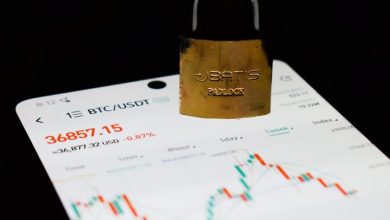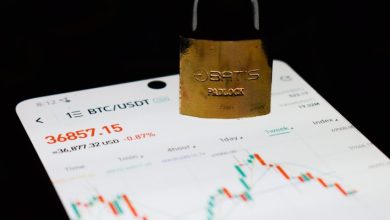Developing a Personal Crypto Risk Management Plan

- Understanding the Basics of Cryptocurrency Risk Management
- Assessing Your Risk Tolerance in the Crypto Market
- Setting Clear Financial Goals for Your Crypto Investments
- Creating a Diversified Crypto Portfolio to Manage Risk
- Implementing Strategies to Protect Your Crypto Assets
- Monitoring and Adjusting Your Risk Management Plan Over Time
Understanding the Basics of Cryptocurrency Risk Management
When it comes to cryptocurrency investments, it is crucial to have a solid understanding of risk management. Cryptocurrency prices are highly volatile, which means that you could potentially lose a substantial amount of your investment in a short period of time. To protect yourself from such risks, it is important to develop a personal crypto risk management plan.
One of the key aspects of crypto risk management is diversification. Diversifying your crypto portfolio across different cryptocurrencies can help reduce the overall risk of your investment. By spreading your investment across various cryptocurrencies, you can mitigate the impact of price fluctuations on any single cryptocurrency.
Another important aspect of crypto risk management is setting stop-loss orders. A stop-loss order is a predetermined price at which you will sell your cryptocurrency to limit your losses. By setting stop-loss orders, you can protect your investment from significant losses in the event of a sudden price drop.
Furthermore, it is essential to stay informed about the crypto market and be aware of any potential risks that could affect your investments. Keeping up to date with crypto news and market trends can help you make informed decisions about your crypto investments and adjust your risk management plan accordingly.
Assessing Your Risk Tolerance in the Crypto Market
When developing a personal crypto risk management plan, it is essential to assess your risk tolerance in the crypto market. Understanding how much risk you are willing to take on can help you make informed decisions about your investments. Here are some key factors to consider when evaluating your risk tolerance:
- Your financial goals: Consider what you hope to achieve by investing in cryptocurrency. Are you looking to make a quick profit, or are you in it for the long haul?
- Your investment timeline: Determine how long you plan to hold onto your investments. Short-term investments are generally riskier than long-term ones.
- Your current financial situation: Assess your current financial standing, including your income, expenses, and any outstanding debts. This will help you determine how much you can afford to invest.
- Your previous investment experience: Reflect on any previous investments you have made and how they have performed. This can give you insight into how comfortable you are with risk.
By carefully evaluating these factors, you can gain a better understanding of your risk tolerance in the crypto market. This knowledge will guide you in creating a risk management plan that aligns with your financial goals and comfort level. Remember, it is crucial to regularly reassess your risk tolerance as your financial situation and investment goals evolve.
Setting Clear Financial Goals for Your Crypto Investments
Setting clear financial goals for your cryptocurrency investments is crucial in developing a personal risk management plan. By defining your objectives, you can establish a roadmap for your investment journey and make informed decisions along the way.
When setting your financial goals, consider factors such as your risk tolerance, investment timeline, and desired returns. Are you looking to generate steady income, or are you aiming for long-term capital growth? Understanding your goals will help you determine the appropriate investment strategies and risk management techniques to employ.
It’s essential to be realistic in setting your financial goals, taking into account the volatile nature of the cryptocurrency market. By setting achievable targets, you can avoid making impulsive decisions based on short-term market fluctuations.
Furthermore, regularly review and reassess your financial goals to ensure they remain relevant and aligned with your evolving investment objectives. Adjust your strategies as needed to stay on track towards achieving your desired outcomes.
Creating a Diversified Crypto Portfolio to Manage Risk
Developing a diversified crypto portfolio is essential for managing risk in the volatile cryptocurrency market. By spreading your investments across various crypto assets, you can protect yourself from volatility in any single coin or token. Here are some strategies to consider when creating a diversified crypto portfolio:
- Include a mix of large-cap, mid-cap, and small-cap cryptocurrencies to balance risk and return.
- Diversify across different use cases and blockchain platforms to reduce exposure to market fluctuations.
- Consider including stablecoins or other hedging assets to protect your portfolio during market downturns.
- Regularly rebalance your portfolio to ensure that it remains diversified and aligned with your investment goals.
Implementing Strategies to Protect Your Crypto Assets
When it comes to safeguarding your cryptocurrency assets, there are several strategies you can implement to minimize the risks of theft or loss. By taking proactive measures, you can better protect your investments and ensure the security of your digital funds.
- Use a Hardware Wallet: One of the most secure ways to store your crypto assets is by using a hardware wallet. These physical devices store your private keys offline, making them less vulnerable to hacking or cyber attacks.
- Enable Two-Factor Authentication: Adding an extra layer of security to your accounts by enabling two-factor authentication can help prevent unauthorized access. This typically involves entering a code sent to your mobile device in addition to your password.
- Keep Your Software Updated: Regularly updating your wallet software and any other applications related to your crypto assets can help patch any security vulnerabilities and protect against potential exploits.
- Use Strong Passwords: Creating complex and unique passwords for your accounts is essential in preventing unauthorized access. Avoid using easily guessable passwords and consider using a password manager for added convenience.
- Be Mindful of Phishing Attempts: Be cautious of any unsolicited emails or messages asking for your personal information or login credentials. Always verify the legitimacy of the source before providing any sensitive data.
By incorporating these strategies into your overall risk management plan, you can enhance the security of your crypto assets and minimize the chances of falling victim to theft or fraud. It’s crucial to stay vigilant and proactive in safeguarding your investments in the ever-evolving landscape of cryptocurrency.
Monitoring and Adjusting Your Risk Management Plan Over Time
Once you have developed a personal crypto risk management plan, it is essential to continuously monitor and adjust it over time. Monitoring allows you to keep track of how well your plan is working and whether any adjustments are needed to better protect your investments.
One way to monitor your risk management plan is to regularly review your portfolio to see how each asset is performing. Keep an eye on market trends and news that could impact the value of your investments. Additionally, it’s important to stay informed about any regulatory changes that could affect the crypto market.
Adjusting your risk management plan may be necessary if you notice any significant changes in the market or if your risk tolerance changes. You may need to rebalance your portfolio by selling off some assets and purchasing others to maintain your desired level of risk. It’s also a good idea to periodically review your stop-loss orders and adjust them as needed to protect your investments from sudden price drops.
By monitoring and adjusting your risk management plan over time, you can ensure that your investments remain protected in the volatile world of cryptocurrency. Stay vigilant and be prepared to make changes as needed to safeguard your financial future.



